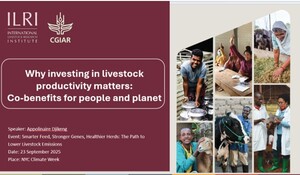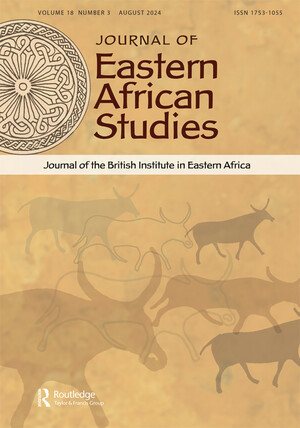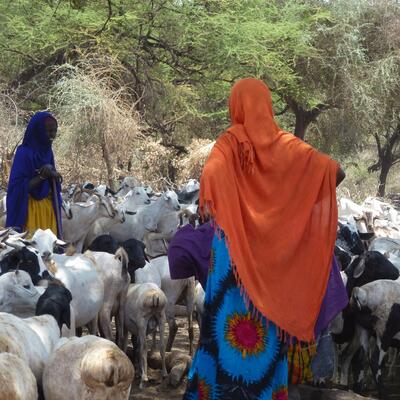
‘Livestock master plan’ launched to transform meat, milk and poultry production in The Gambia
 Goats in a West African village (photo credit: ILRI).
Goats in a West African village (photo credit: ILRI).
Farming dominates the economy of The Gambia, a small, narrow West African country (the smallest country in mainland Africa, which is less than 50 km wide at its widest point). Surrounded on three sides by Senegal, the country has an Atlantic coastline to the west, with its borders mirroring The Gambia River, which flows through the centre of the country before emptying into the Atlantic Ocean. (That the river is navigable deep into the continent made The Gambia central both to the slave trade in the 17th—18th centuries and to its subsequent abolition in the 19th century.)
A third of the Gambian population of some 1.7 million people, still live below the international poverty line of USD1.25 a day, with most of the poor living in rural areas. With its fertile land, agriculture accounts for some 23% of gross domestic product (GDP) and employs 75% of the labour force. Within agriculture (which is dominated by groundnuts), livestock account for 5.3% of GDP.
Last week (on 19 Nov 2020), a ‘livestock master plan’ was launched by the country’s Permanent Secretary in the Ministry of Agriculture, Ebrima Sissaho, at the Department of Livestock Services headquarters in Abuko, just outside the capital of Banjul. The plan is a detailed roadmap for enhancing investment in the country’s livestock sector. Based on recent research evidence, the plan provides a vision and strategy for the country’s livestock sector, targets for the country’s livestock sector to meet, a budget covering both the human and financial resources needed for a growing livestock sector, and a sequential plan of action to meet the new targets.
This new livestock master plan is an integral part of The Gambia’s ongoing Small Ruminant Production Enhancement Project (SRPEP), which is funded by the Islamic Development Bank. The small ruminant project works to improve the livelihoods of members of more than 30,000 livestock-producing households. It does this by improving the productivity of local breeds of goats and sheep through enhanced feeding and husbandry practices, fostering greater access to veterinary services as well as boreholes and other production infrastructure and bolstering livestock markets.
During a first meeting to launch The Gambia’s livestock master plan, Karl Rich, principal scientist in the Policies, Institutions, and Livelihoods (PIL) Program of the International Livestock Research Institute (ILRI), and Njie Mamud, program director of SRPEP, both pointed to an increasing demand for animal-source foods (milk, meat and eggs) locally and internationally that the country was as yet unable to supply due to challenges in the country’s livestock production and feed systems, fragmentation of its livestock value chains and poor infrastructure. Rich argued that by working with many diverse stakeholders to implement its new livestock master plan, The Gambia will be able to help its smallholder farmers transform their largely subsistence livestock systems into a profitable and thriving livestock sector.
Mamadou Ceesay, chair of The Gambia National Assembly Select Committee on Agriculture, stressed the need to obtain data still missing on various components of the country’s livestock sector. Permanent Secretary Sissaho said he was convinced that ‘implementing the livestock master plan will help restore the country’s export capacity in small ruminant production to previous levels.’
Souleymane Kebe, of the Islamic Development Bank, expressed gratitude that ‘the livestock master plan provides The Gambia not only with a viable action plan but also, from surveys to be conducted, with credible evidence of the current status of the sector.’
Describing the whole of The Gambia’s livestock master plan project, Isabelle Baltenweck, leader of ILRI’s PIL Program, said: ‘ILRI is delighted to work with The Gambia and the Islamic Development Bank in this project, bringing its many years of experience and expertise in livestock master planning to support this nation in meeting its ambitious and sustainable livestock-sector development goals.’
The Gambia’s livestock master plan is expected to enhance the livelihoods of rural and peri-urban communities not only by strengthening the productivity and resilience of their ruminant production systems but also by supporting the creation of livestock businesses, particularly those run by young people and by women.
The project will focus on enhancing the sustainable development of small ruminant production systems specifically through greater support for herd health, improved genetics, greater access to animal feeds and pastures, better management of livestock production and marketing systems, adoption of innovative techniques for processing livestock products, and by providing small-scale livestock producers with greater access to finance.
The Gambia’s Livestock Master Plan will be implemented in all 39 districts of the country, providing both a useful national-level overview of the sector and a practical roadmap distinguishing many opportunities for smart investments in the country’s all-important meat, milk and poultry value chains.
Broadcast media coverage of The Gambia-ILRI livestock master plan meeting can be found on GRTS TV, https://fb.watch/1Tki8PU0jx/, and on QTV, https://fb.watch/1TjaHRck8a/.



















